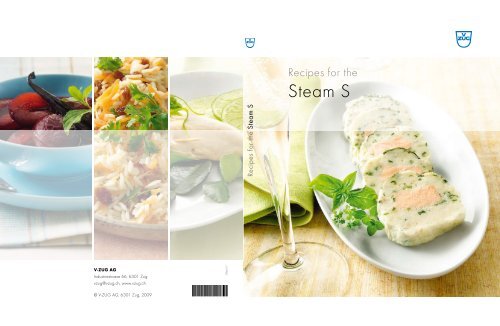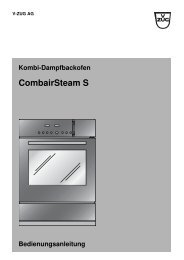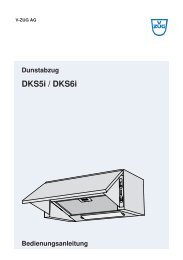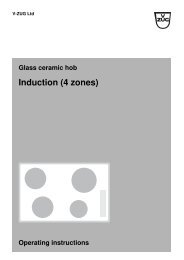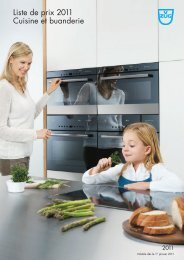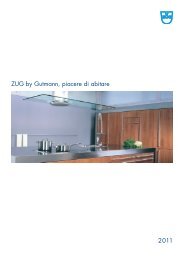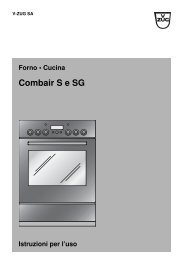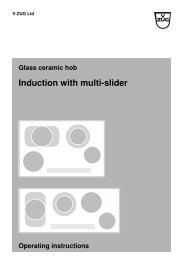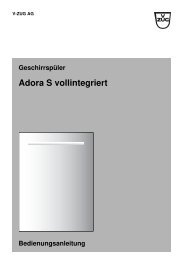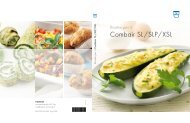Recipe book Steam S (PDF / 3.0 MB) - V-ZUG Ltd
Recipe book Steam S (PDF / 3.0 MB) - V-ZUG Ltd
Recipe book Steam S (PDF / 3.0 MB) - V-ZUG Ltd
Create successful ePaper yourself
Turn your PDF publications into a flip-book with our unique Google optimized e-Paper software.
<strong>Recipe</strong>s for the<br />
<strong>Steam</strong> S<br />
<strong>Recipe</strong>s for the <strong>Steam</strong> S<br />
V-<strong>ZUG</strong> AG<br />
Industriestrasse 66, 6301 Zug<br />
vzug@vzug.ch, www.vzug.ch<br />
J766.017<br />
© V-<strong>ZUG</strong> AG, 6301 Zug, 2009
Delicious recipes
Delicious recipes
Contents<br />
Theory<br />
7 General information<br />
8 Operating modes<br />
10 Accessories<br />
11 Operating the appliance<br />
12 Uses and tips<br />
14 Notes and abbreviations<br />
Vegetable<br />
64 Vegetable patch<br />
66 Spring vegetables<br />
68 Asparagus with red hollandaise sauce<br />
70 Colourful bean platter<br />
72 Stuffed kohlrabies<br />
74 Mediterranean vegetables<br />
Starters<br />
18 Zander and salmon terrine<br />
20 Poultry terrine<br />
22 Game terrine<br />
24 Carrot and cheese flan<br />
26 Vegetable terrine Italia<br />
Desserts<br />
78 Orange and caramel flan<br />
80 Chocolate and gingerbread flan<br />
80 Coconut flan<br />
82 Plums in red wine<br />
84 Fruit compote<br />
Fish Poultry Meat<br />
30 Fish rolls<br />
32 <strong>Steam</strong>ed fish fillets<br />
34 Colourful fish brochette<br />
36 Veal fillet coated in herbs<br />
38 Beef stroganoff<br />
40 Stewing meat<br />
42 Lime chicken breast<br />
44 Bernese platter<br />
46 Minced-meat and savoy rolls<br />
Accompaniments Gratins<br />
50 Stuffed potatoes<br />
52 Oriental rice<br />
54 Risotto variations<br />
56 Polenta with vegetables<br />
58 Lentils with semolina gnocchi<br />
60 Ebly wheat with peppers and courgettes
General information<br />
Healthy cooking is part of modern life<br />
Ever more health-conscious people are choosing gentle<br />
methods of cooking, because being sporty and fit<br />
is part of the modern lifestyle. Part and parcel with this are<br />
culinary delights, for the steamer satisfies both requirements.<br />
A steamer makes healthy food even tastier and as if<br />
prepared by a master chef. <strong>Steam</strong>ing also eliminates<br />
constant watching. Nothing is overcooked, nothing burns.<br />
Head and hands are free for other tasks.<br />
Function principle of operating modes using steam<br />
The principle of your appliance is very simple. Water is<br />
brought to the boil in a boiler. The steam produced<br />
is fed into the cooking space where it condenses on the<br />
colder surface of the food to water and the energy<br />
is transferred to the food.<br />
The bigger the surface area of the food, the quicker it will<br />
cook. Simply cut the food into smaller pieces to increase the<br />
surface area. For steaming, use the perforated cooking<br />
tray so that the steam reaches all parts of the food uniformly.<br />
The energy transfer of steam is very efficient, with the<br />
food being heated evenly as more steam condenses on the<br />
thicker parts and energy in the form of heat is transferred<br />
into the food.<br />
Important note<br />
The operating instructions contain important safety information.<br />
Please read this carefully before you use the<br />
appliance. The operating instructions also contain detailed<br />
information for using the appliance.<br />
6 7 Theory
Operating modes<br />
n Place tins, moulds, etc. on the stainless steel tray.<br />
The appliance has four preset cooking space temperatures for steaming which cannot be changed. Follow the advice in<br />
«Tips on settings» and in «Tips and tricks».<br />
Operating mode Temperature range Level<br />
Use<br />
Heating method<br />
<strong>Steam</strong>ing 100 °C 1 to 4<br />
Cooking vegetables. Cooking rice, cereal<br />
products and pulses. Cooking meat (ham, smoked<br />
pork loin or ribs). Cooking mussels.<br />
Extracting juice from fruit and berries. Regenerating,<br />
defrosting and simultaneously cooking<br />
vegetables. Place the stainless steel tray underneath<br />
the perforated cooking tray.<br />
The cooking space is heated by steam.<br />
The food is heated up or cooked by<br />
steaming.<br />
4<br />
3<br />
2<br />
1<br />
<strong>Steam</strong>ing 90 °C 1 to 4<br />
Cooking dishes that contain egg (creams and<br />
custards). Preserving fruit. For gently regenerating<br />
dishes.<br />
Place the stainless steel tray underneath<br />
the perforated cooking tray.<br />
The cooking space is heated by steam.<br />
The food is heated up or cooked by<br />
steaming.<br />
4<br />
3<br />
2<br />
1<br />
<strong>Steam</strong>ing 80 °C 1 to 4<br />
Poaching and cooking meat (fillet) and fish.<br />
Place the stainless steel tray underneath the perforated<br />
cooking tray.<br />
The cooking space is heated by steam.<br />
The food is heated up or cooked by<br />
steaming.<br />
4<br />
3<br />
2<br />
1<br />
<strong>Steam</strong>ing 40 °C 1 to 4<br />
Defrosting sensitive food, e. g. meat and fish.<br />
For making joghurt.<br />
Place the stainless steel tray underneath the<br />
perforated cooking tray.<br />
The cooking space is heated by steam.<br />
The food is heated up or cooked by<br />
steaming.<br />
4<br />
3<br />
2<br />
1<br />
8 9 Theory
Accessories<br />
Operating the appliance<br />
Accessories<br />
Perforated cooking tray<br />
Operating the appliance<br />
Below are brief operating instructions for quick reference.<br />
Additional and more detailed information is to be<br />
found in the operating instructions.<br />
n Place the food in the cooking space.<br />
Wire shelf<br />
n Fill the water tank up to the «1.25 litre» mark with fresh,<br />
cold drinking water and slot into position in the water tank<br />
compartment.<br />
n Press the button for the required operating mode once or<br />
more.<br />
n Press the OK adjusting knob to start the appliance<br />
Stainless steel tray<br />
immediately.<br />
n Press the Off button to finish cooking.<br />
n When the appliance is switched off, the residual water is<br />
pumped back into the water tank.<br />
n Take the cooked food out of the cooking space.<br />
Unperforated cooking tray<br />
n If any water has collected on the bottom of the cooking<br />
space, allow it to cool before wiping it up with a soft<br />
cloth.<br />
n Remove and empty the water tank and then put it back in<br />
the appliance.<br />
n Leave the appliance door open in the at-rest position to<br />
Porcelain dish<br />
Terrine mould<br />
enable the cooking space to cool down.<br />
Saving energy – Menu preparation<br />
When steaming, a variety of food can be cooked at<br />
the same time. For example, rice or pulses can be prepared<br />
at the same time as vegetables with similar cooking<br />
times, saving energy and the washing-up.<br />
A continuous fresh supply of steam from the external boiler<br />
prevents transfer of flavours between foods.<br />
Where food has different cooking times, place it staggered<br />
in the cooking space.<br />
The perforated and unperforated cooking tray is supplied in Gastronorm (GN) sizes ⅓ and ⅔ and the porcelain dish<br />
in sizes ⅓, ½ and ⅔ GN.<br />
10 11 Theory
Uses and tips<br />
Uses and tips<br />
Regeneration<br />
Prepared dishes and convenience foods can be<br />
heated up directly on a heat-resistance plate using steam<br />
without any loss of quality and be served as if freshly<br />
prepared. The food does not have to be covered and can<br />
be regenerated on several levels at the same time.<br />
Defrosting<br />
Deep frozen meat, fish and poultry can be gently defrosted<br />
with <strong>Steam</strong> 40 °C. Deep frozen vegetables can be<br />
prepared with <strong>Steam</strong> 100 °C, just like fresh vegetables.<br />
Preserving<br />
With steam, food can be prepared for preserving in glass<br />
containers and infant feeding bottles can be sterilised.<br />
The food is preserved by killing any microorganisms and<br />
then hermetically sealing it in jars. See the «Tips on<br />
settings» section for details.<br />
Blanching<br />
Blanching refers to the preparation of food by putting<br />
it briefly into plenty of boiling water. Blanch food<br />
in the steamer by steaming it briefly at 100 °C. The<br />
enzymes are deactivated by the heat, while the colour of<br />
the vegetables is retained. Similarly, leafy vegetables<br />
(e. g. white cabbage) are softened, making them easier<br />
to prepare and freeze. After blanching, plunge the<br />
vegetables straight into ice-cold water and then dry.<br />
<strong>Steam</strong>ing<br />
Vital vitamins, minerals and flavours are retained during the<br />
process of being gently steamed in the steamer. Not<br />
matter the food, there is an operating mode to steam it to<br />
perfection.<br />
Grains (e. g. rice and millet) and pulses (e. g. lentils), adding<br />
an appropriate amount of liquid, can be cooked directly<br />
in suitable tableware.<br />
Type of food Weight Approximate amount of liquid to be added<br />
(depending on desired consistency)<br />
Rice 100 g 1.5 dl (salted water, bouillon, etc.)<br />
Risotto 100 g 2.5 dl (water, wine, etc.)<br />
Maize semolina (polenta) 100 g 3 dl (water / milk mixture)<br />
Semolina 100 g 2 to 3 dl water<br />
Lentils 100 g 2 to 3 dl water<br />
Ebly wheat 100 g 1 to 1.5 dl water<br />
Millet 100 g 1.5 to 2 dl water<br />
Chickpeas, soaked 100 g 0.5 to 1 dl water<br />
Juice extracting<br />
<strong>Steam</strong> juicing is a very gentle method of extracting<br />
juice from berries and fruits, for instance cherries, blackcurrants,<br />
etc. The energy-rich steam bursts the cell<br />
walls, allowing the juice to escape.<br />
12 13 Theory
Notes and abbreviations<br />
Ingredients<br />
The recipes serve four, unless stated otherwise.<br />
Cooking time<br />
The cooking times given are based on the stated accessories.<br />
The cooking time may vary slightly depending on<br />
the type of cookware being used. The cooking times given<br />
serve as a guide. The duration can be shortened for<br />
firmer or lengthened for more well cooked food, according<br />
to individual preference.<br />
The following abbreviations are used in the recipes:<br />
g<br />
gram<br />
kg kilogram<br />
dl decilitre<br />
l<br />
litre<br />
tsp teaspoon<br />
tbsp tablespoon<br />
Quantities<br />
Ingredients<br />
Flat<br />
teaspoon<br />
Flat<br />
tablespoon<br />
Heaped<br />
teaspoon<br />
Heaped<br />
tablespoon<br />
Baking powder 3 g 6 g 7 g 13 g<br />
Butter 3 g 8 g 10 g 18 g<br />
Honey 6 g 13 g 12 g 26 g<br />
Jam 6 g 18 g 14 g 36 g<br />
Flour 3 g 7 g 5 g 15 g<br />
Oil 3 g 12 g – –<br />
Salt 5 g 13 g 8 g 24 g<br />
Mustard 4 g 12 g 11 g 26 g<br />
Water, milk 5 g 15 g – –<br />
Cinnamon 2 g 3 g 4 g 11 g<br />
Sugar 3 g 9 g 6 g 17 g<br />
14 15 Theory
Starters
Zander and salmon terrine<br />
1<br />
2<br />
3<br />
4<br />
5<br />
6<br />
Put the diced zander into the freezer for 30 minutes.<br />
Line the terrine mould with cling film, leaving enough spare<br />
to cover the terrine, once filled. Lay the basil leaves in<br />
the bottom of the terrine mould.<br />
Puree the double cream with the frozen diced zander in<br />
a blender or using a hand-held mixer, add the herbs and<br />
season with salt and pepper.<br />
Put half of the zander mixture into the mould. Lay the salmon<br />
strips across the centre, lengthways. Spread the rest of<br />
the zander mixture on top. Cover the terrine with cling film.<br />
Put the terrine mould on to the stainless steel tray at level 2<br />
of the cold cooking space. <strong>Steam</strong> 100 °C, 20 minutes.<br />
Remove the cling film from the top of the terrine. Allow the terrine<br />
to stand for at least 20 minutes, before turning it out.<br />
Half-round terrine mould, 0.7 l<br />
Stainless steel tray, ⅔ GN<br />
300 g fresh fillet of zander, diced<br />
5–6 basil leaves<br />
1 bunch of chives or dill,<br />
finely chopped<br />
1½ dl double cream<br />
Salt<br />
Pepper<br />
100 g salmon fillet, in strips<br />
Tip<br />
The terrine can be eaten hot or cold.<br />
Preparation: 60 minutes | Cooking: 20 minutes<br />
18 19 Starters
Poultry terrine<br />
1<br />
2<br />
3<br />
4<br />
Line the terrine mould with cling film, leaving enough spare to<br />
cover the terrine once it is filled.<br />
Puree the diced chicken breast with the double cream in a<br />
blender or using a hand-held mixer, then season with salt and<br />
pepper. Stir in the cranberries and pistachio nuts.<br />
Fill the corners of the terrine mould with the chicken mixture first,<br />
then add the rest of the mixture and smooth off the surface.<br />
Cover the terrine with the cling film.<br />
Put the terrine mould on to the stainless steel tray at level 2<br />
of the cold cooking space. <strong>Steam</strong> 100 °C, 15 minutes.<br />
Triangular terrine mould, 0.45 l<br />
Stainless steel tray, ⅔ GN<br />
300 g chicken breast, finely diced<br />
1¾ dl double cream<br />
Salt<br />
Pepper<br />
50 g cranberries<br />
50 g pistachio nuts, shelled<br />
Preparation: 30 minutes | Cooking: 15 minutes<br />
20 21 Starters
Game terrine<br />
1<br />
2<br />
3<br />
4<br />
5<br />
6<br />
7<br />
8<br />
The day before you want to cook the dish, put all the<br />
ingredients for the marinade into the porcelain dish, along with<br />
the diced venison, cover and leave in the refrigerator to<br />
marinate for 12 hours.<br />
Mix the lingonberries with 2 tbsp of Williams pear liqueur,<br />
cover and leave to marinate at room temperature for 12 hours.<br />
Take the diced venison out of the marinade and pat it dry.<br />
Sieve the marinade and put it to one side.<br />
Put the marinated venison and the bacon into the porcelain<br />
dish. Cover and put the porcelain dish into the cold cooking<br />
space at level 2. <strong>Steam</strong> 100 °C, 10 minutes.<br />
Put the venison strips into a frying pan with the oil and sear<br />
well, then remove them from the pan. Pour the game stock into<br />
the pan to deglaze the fond, add the Williams pear liqueur<br />
and allow the stock to reduce by half over a low heat.<br />
Take the porcelain dish out of the cooking space and pour<br />
the liquid over it. Puree small batches of the meat in a blender,<br />
adding a little crème fraîche each time. Stir the reduced<br />
game stock, lingonberries and parsley into the meat mixture<br />
and season well with salt and pepper.<br />
Line the terrine mould with cling film, leaving enough spare to<br />
cover the terrine, once filled. Put half of the meat mixture<br />
into the mould, lay the strips of venison over the top, cover with<br />
the remaining meat mixture and smooth off. Cover the terrine<br />
with the cling film.<br />
Put the terrine mould on to the stainless steel tray at level 2<br />
of the warm cooking space. <strong>Steam</strong> 90 °C, 20 minutes.<br />
Porcelain dish, ⅓ GN<br />
Half-round terrine mould, 0.7 l<br />
Stainless steel tray, ⅔ GN<br />
Marinade<br />
1 dl red wine<br />
1 shallot, quartered<br />
½ tbsp red pepper corns<br />
2 bay leaves<br />
400–500 g venison,<br />
cut into 3–4 cm cubes<br />
25 g dried lingonberries or<br />
cranberries<br />
2 tbsp Williams pear liqueur<br />
The next day<br />
50 g bacon, in thin strips<br />
100 g streaky bacon, finely diced<br />
70–100 g venison shoulder steak, in<br />
strips 2 cm thick<br />
1 tbsp oil<br />
½ dl game stock<br />
1½ tbsp Williams pear liqueur<br />
50 g crème fraîche<br />
2–3 stalks of flat-leaf parsley, leaves<br />
pulled off and finely chopped<br />
Salt<br />
Pepper<br />
Preparation: 60 minutes | Cooking: 30 minutes<br />
22 23 Starters
Carrot and cheese flan<br />
1<br />
2<br />
3<br />
4<br />
Puree the carrots in a blender or using a hand-held mixer.<br />
Mix the eggs, cream, milk, cheese and carrots together, then<br />
season.<br />
Put the dishes on the stainless steel tray and divide the mixture<br />
between them evenly.<br />
Put the dishes and the stainless steel tray into the cold cooking<br />
space at level 2. <strong>Steam</strong> 90 °C, 30 minutes.<br />
4–6 flan dishes, Ø 7 cm<br />
Stainless steel tray, ⅔ GN<br />
300 g carrots, finely chopped<br />
4 eggs<br />
2½ dl cream<br />
½ dl milk<br />
50 g grated cheese<br />
Salt<br />
Pepper<br />
Nutmeg<br />
Preparation: 20 minutes | Cooking: 30 minutes<br />
24 25 Starters
Vegetable terrine Italia<br />
1<br />
2<br />
3<br />
4<br />
5<br />
Put the vegetables in the perforated cooking tray and put<br />
the tray into the cold cooking space at level 2. <strong>Steam</strong><br />
100 °C, 20 minutes.<br />
Puree each vegetable separately, mixing 1 tbsp double cream,<br />
1 egg, salt, pepper and nutmeg with each.<br />
Season the carrot mixture with freshly grated ginger. Press<br />
the pea mixture through a sieve to remove the skins.<br />
Line the terrine mould with cling film, leaving enough spare to<br />
cover the terrine, once filled. Put the carrot, cauliflower and pea<br />
mixtures into the mould, in that order. Cover the terrine with<br />
cling film.<br />
Put the terrine mould on to the stainless steel tray at level 2<br />
of the cold cooking space. <strong>Steam</strong> 100 °C, 20 minutes.<br />
Perforated cooking tray, ⅔ GN<br />
Triangular terrine mould, 0.45 l<br />
Stainless steel tray, ⅔ GN<br />
250 g frozen green peas<br />
200 g cauliflower, small florets<br />
100 g carrots, peeled, diced<br />
3 tbsp double cream<br />
3 eggs, each at least 63 g<br />
Salt<br />
Pepper<br />
Nutmeg<br />
Ginger, freshly grated<br />
Tip<br />
Eat the terrine hot or cold.<br />
Preparation: 40 minutes | Cooking: 40 minutes<br />
26 27 Starters
Fish<br />
Poultry<br />
Meat
Fish rolls<br />
1<br />
2<br />
Season the lemon sole fillets with salt and pepper. Spread<br />
the rocket and pine nuts on the fish fillets, roll the fillets up from<br />
the pointed end, then secure them with toothpicks. Grease<br />
the perforated cooking tray and put the fish rolls in it.<br />
Put the perforated cooking tray into the cold cooking space<br />
at level 2. <strong>Steam</strong> 80 °C, 10 minutes.<br />
Toothpicks<br />
Perforated cooking tray, ⅔ GN<br />
8 lemon sole fillets<br />
Salt<br />
Pepper<br />
100 g rocket<br />
20 g pine nuts<br />
Tips<br />
Greasing the cooking tray prevents the fish rolls from sticking<br />
to it.<br />
To make the dish more colourful, use 4 red and 4 white fish<br />
fillets.<br />
Preparation: 15 minutes | Cooking: 10 minutes<br />
30 31 Fish Poultry Meat
<strong>Steam</strong>ed fish fillets<br />
Porcelain dish, ½ GN<br />
1<br />
2<br />
3<br />
4<br />
Peel the tomatoes and cut out the stalks. Quarter the tomatoes,<br />
remove the seeds and pulp, then dice the remaining flesh.<br />
Sweat the shallots and garlic in the olive oil, then stir in the thyme<br />
and oregano.<br />
Place layers of fish fillet, courgette, mushroom and tomato into<br />
the greased porcelain dish, adding a little of the shallot mixture at<br />
each stage, season with salt and pepper, then drizzle with<br />
the white wine.<br />
Put the porcelain dish into the cold cooking space at level 2.<br />
<strong>Steam</strong> 100 °C, 20 minutes.<br />
Tip<br />
To peel tomatoes: cut a cross into the top of each tomato, use<br />
a slotted spoon to lower them into boiling water until the skin<br />
starts to come away, then rinse the tomatoes in cold water and<br />
peel them.<br />
2 medium-sized beef tomatoes<br />
1–2 shallots, finely diced<br />
1 small clove of garlic, finely diced<br />
3 tbsp olive oil<br />
Thyme sprigs, leaves pulled off<br />
Oregano, fresh or dried<br />
500 g fillets of fish<br />
2 courgettes, finely sliced<br />
150 g mushrooms, sliced<br />
Salt<br />
Pepper<br />
White wine for drizzling<br />
Preparation: 30 minutes | Cooking: 20 minutes<br />
32 33 Fish Poultry Meat
Colourful fish brochette<br />
1<br />
2<br />
3<br />
4<br />
Cut the pepper in half, remove the stalk, seeds and white<br />
membranes, then cut into 3 cm squares. Cut the stalk<br />
off the top of the courgette, then cut it into slices 15 mm thick.<br />
Thread cubes of salmon, pieces of pepper and slices<br />
of courgette on to short skewers, alternating between salmon,<br />
pepper and courgette, then season.<br />
Put the skewers on the stainless steel tray.<br />
Put the stainless steel tray into the cold cooking space<br />
at level 2. <strong>Steam</strong> 100 °C, 15 minutes.<br />
Short skewers<br />
Stainless steel tray, ⅔ GN<br />
1 yellow pepper<br />
1–2 courgettes<br />
300 g salmon fillet,<br />
cut into 3 cm cubes<br />
Salt<br />
Pepper<br />
Preparation: 15 minutes | Cooking: 15 minutes<br />
34 35 Fish Poultry Meat
Veal fillet coated in herbs<br />
1<br />
2<br />
3<br />
4<br />
5<br />
6<br />
Pull the parsley, chervil, thyme, marjoram and tarragon leaves<br />
off the stalks and chop them; finely chop the chives. Mix the<br />
herbs with a little olive oil.<br />
Put a piece of cling film 20 cm longer than the fillet on to<br />
the work surface and lay the herbs along the middle of the cling<br />
film, in a row that is the same length as the veal. Season the<br />
fillet with salt and pepper, turn it over in the herbs and wrap it in<br />
the cling film. Wrap this parcel in aluminium foil, sealing the<br />
ends up well. Put the wrapped fillet on to the stainless steel tray.<br />
Put the stainless steel tray into the cold cooking space at<br />
level 2. <strong>Steam</strong> 100 °C, 40 minutes.<br />
For the herb jus, sweat the onion and herbs in the butter, pour<br />
in the port and allow to reduce by half, then add the veal<br />
stock, bring to the boil and leave to simmer for 10 minutes. Pour<br />
the sauce through a sieve.<br />
Take the fillet out of the cooking space, leave to rest for a few<br />
minutes, remove the foil and film, then slice it up.<br />
Pour a little of the herb jus on to the plate and arrange the<br />
fillet on top.<br />
Stainless steel tray, ⅔ GN<br />
50 g mixed herbs: parsley, chervil,<br />
thyme, marjoram, tarragon, chives<br />
Olive oil<br />
600 g fillet of veal, centre cut<br />
Salt<br />
Pepper<br />
Herb jus<br />
1 small onion, finely diced<br />
2 tbsp mixed herbs: parsley, chervil,<br />
thyme, marjoram, tarragon, chives<br />
1 tbsp butter<br />
1 dl port wine<br />
2 dl brown veal stock<br />
Preparation: 30 minutes | Cooking: 40 minutes<br />
36 37 Fish Poultry Meat
Beef stroganoff<br />
Porcelain dish, ½ GN<br />
1<br />
2<br />
3<br />
4<br />
5<br />
6<br />
Season the meat with salt and pepper.<br />
Cut the peppers in half, remove the stalks, seeds and white<br />
membranes, then cut into strips.<br />
Put the meat in the porcelain dish and scatter the beef bouillon<br />
powder, peppers and onions over the top.<br />
Put the porcelain dish into the cold cooking space at level 2.<br />
<strong>Steam</strong> 100 °C, 40 minutes.<br />
Pour out and collect the juices from the porcelain dish, stir<br />
the gravy powder, tomato puree, the thickened cream and<br />
paprika into the juices, then add this sauce to the meat.<br />
Put the porcelain dish into the warm cooking space at level 2.<br />
<strong>Steam</strong> 100 °C, 6–8 minutes. Season to taste before<br />
serving.<br />
Tip<br />
Serve with polenta.<br />
800 g shoulder of beef,<br />
in strips 1 cm thick<br />
Salt<br />
Pepper<br />
1 tsp beef bouillon powder<br />
2 yellow peppers<br />
2 red peppers<br />
2 green peppers<br />
2 onions, finely diced<br />
Sauce<br />
3–4 tbsp gravy powder<br />
2 tbsp tomato puree<br />
180 g thickened cream<br />
for making sauces<br />
Paprika powder<br />
Preparation: 30 minutes | Cooking: 47 minutes<br />
38 39 Fish Poultry Meat
Stewing meat<br />
Cooking tray unperforated,<br />
10 cm high, ⅓ GN<br />
1<br />
2<br />
Put the meat, vegetables and spices in the cooking tray,<br />
then add the vegetable bouillon. The bouillon must cover<br />
the meat.<br />
Put the cooking tray into the cold cooking space at level 2.<br />
<strong>Steam</strong> 100 °C, 90–120 minutes (depending on the thickness<br />
of the meat).<br />
Tip<br />
If you are serving potatoes as an accompaniment, they can<br />
be cooked along with the meat.<br />
1 kg beef, brisket flat cut or brisket<br />
point cut<br />
2 carrots, peeled, quartered<br />
½ small celeriac, peeled, quartered<br />
2 small onions<br />
1 bay leaf<br />
2 cloves<br />
4 black pepper corns<br />
½–1 l vegetable bouillon<br />
Preparation: 20 minutes | Cooking: 2 hours<br />
40 41 Fish Poultry Meat
Lime chicken breast<br />
Perforated cooking tray, ⅔ GN<br />
Toothpicks<br />
1<br />
2<br />
3<br />
Mix all the stuffing ingredients together.<br />
Use a sharp, pointed knife to cut a pocket into each chicken<br />
breast (or ask your butcher to do this for you), season and<br />
stuff with the ricotta mixture. Close the chicken breasts with a<br />
toothpick. Put the chicken into the perforated cooking tray.<br />
Put the perforated cooking tray into the cold cooking space at<br />
level 2. <strong>Steam</strong> 90 °C, 20 minutes.<br />
Tip<br />
Garnish with slices of lime and kaffir lime leaves as you wish.<br />
4 chicken breasts,<br />
around 120 g each<br />
Salt<br />
Pepper<br />
Stuffing<br />
½ lime, zest and juice<br />
75 g ricotta<br />
1 tsp lemon pepper<br />
2 tbsp grated Parmesan<br />
Salt<br />
Paprika powder<br />
Preparation: 20 minutes | Cooking: 20 minutes<br />
42 43 Fish Poultry Meat
Bernese platter<br />
1<br />
2<br />
Put the bacon, smoked pork loin and saucisson vaudoise<br />
into the cooking tray. Spread the sauerkraut over the meat and<br />
lay the potatoes on top.<br />
Put the cooking tray into the cold cooking space at level 2.<br />
<strong>Steam</strong> 100 °C, 40–50 minutes.<br />
Cooking tray unperforated,<br />
10 cm high, ⅓ GN<br />
150 g smoked bacon<br />
250 g smoked pork loin<br />
200 g saucisson vaudoise<br />
½–1 kg cooked sauerkraut<br />
1 kg waxy potatoes, peeled<br />
Tip<br />
Cook raw sauerkraut for an additional 30–60 minutes.<br />
Soak some dried beans and cook them on top of the sauerkraut.<br />
Preparation: 15 minutes | Cooking: 50 minutes<br />
44 45 Fish Poultry Meat
Minced-meat<br />
and savoy rolls<br />
Perforated cooking tray, ⅔ GN<br />
Porcelain dish, ½ GN<br />
1<br />
2<br />
3<br />
4<br />
5<br />
6<br />
Put the cabbages leaves in the perforated cooking tray.<br />
Put the perforated cooking tray into the cold cooking space at<br />
level 2. <strong>Steam</strong> 100 °C, 10 minutes.<br />
Combine the ingredients for the minced-meat mixture to form<br />
a compact mass.<br />
Use a fork to crush the feta, then mix in the single cream, olives<br />
and basil.<br />
Put some of the minced-meat mixture onto each cabbage leaf<br />
and press it down flat, put the feta mixture on top, then roll<br />
up the cabbage leaves and place them in the porcelain dish.<br />
Pour the vegetable bouillon into the dish.<br />
Put the porcelain dish into the warm cooking space at level 2.<br />
<strong>Steam</strong> 100 °C, 30 minutes.<br />
1 Savoy cabbage<br />
2 dl vegetable bouillon<br />
Minced-meat mixture<br />
400 g minced-meat,<br />
half veal / half beef<br />
2 small onions, finely diced<br />
1 clove of garlic, finely diced<br />
8 tbsp seasoned breadcrumbs<br />
2 eggs<br />
1 bunch of parsley, leaves pulled off<br />
from stalks and chopped<br />
1 bunch of chives, finely chopped<br />
Salt<br />
Pepper<br />
Feta mixture<br />
200 g feta<br />
2 tbsp single cream<br />
10–12 pitted black olives, sliced<br />
1 bunch of basil, finely chopped<br />
Preparation: 40 minutes | Cooking: 40 minutes<br />
46 47 Fish Poultry Meat
Accompaniments<br />
Gratins
Stuffed potatoes<br />
1<br />
2<br />
3<br />
4<br />
5<br />
Leaving the skins on, cut the potatoes in half lengthways and<br />
use a melon ball scoop to hollow them out a little.<br />
Mix the marjoram leaves, spinach and feta together, then<br />
season with salt and pepper. Stir the hollowed-out potato into<br />
this mixture.<br />
Put the potato halves into the porcelain dish and fill them<br />
with the mixture.<br />
Put the porcelain dish into the cold cooking space at level 2.<br />
<strong>Steam</strong> 100 °C, 30 minutes.<br />
Sprinkle the stuffed potatoes with the chopped walnuts and<br />
serve.<br />
Porcelain dish, ½ GN<br />
4 large, waxy potatoes<br />
1 egg, beaten<br />
3 marjoram sprigs, leaves pulled off<br />
50 g baby spinach, shredded<br />
100 g feta cheese, diced<br />
Salt<br />
Pepper<br />
50 g walnuts, roughly chopped<br />
Tips<br />
For a stronger flavour, replace the feta with Gorgonzola or<br />
Roquefort.<br />
You can replace the spinach with herbs of your choice.<br />
Preparation: 30 minutes | Cooking: 30 minutes<br />
50 51 Accompaniments Gratins
Oriental rice<br />
1<br />
2<br />
3<br />
4<br />
Peel the carrots and grate them roughly.<br />
Put all the ingredients in the porcelain dish and mix together.<br />
Put the porcelain dish into the cold cooking space at level 2.<br />
<strong>Steam</strong> 100 °C, 25 minutes.<br />
When the appliance switches off, leave the rice inside to rest<br />
for 5–10 minutes. Garnish with coriander.<br />
Porcelain dish, ⅓ GN<br />
2 carrots<br />
200 g parboiled rice<br />
50 g raisins<br />
1 small piece of ginger, around 2 cm,<br />
peeled, finely diced (brunoise)<br />
3 dl vegetable bouillon<br />
Coriander<br />
Preparation: 10 minutes | Cooking: 25 minutes<br />
52 53 Accompaniments Gratins
Risotto variations<br />
Porcelain dish, ⅓ GN<br />
1<br />
2<br />
3<br />
Put the risotto rice, white wine, bouillon, lemon grass and<br />
lemon thyme sprigs in the porcelain dish and mix together.<br />
Put the porcelain dish into the cold cooking space at level 2.<br />
<strong>Steam</strong> 100 °C, 35 minutes.<br />
Once the dish is cooked, take out the lemon grass and lemon<br />
thyme. Add the chives, lemon juice, mascarpone, butter and<br />
Parmesan and stir.<br />
Tips<br />
Replace the lemon grass, lemon juice and mascarpone with<br />
fromage frais, herbs and diced vegetables. Cook the diced<br />
vegetables together with the rice.<br />
200 g risotto rice, such as carnaroli<br />
1 dl dry white wine<br />
4½ dl bouillon<br />
2 sticks of lemon grass,<br />
halved lengthways<br />
2–3 lemon thyme sprigs<br />
1 bunch of chives, finely chopped<br />
1 lemon, juice<br />
1 tbsp mascarpone<br />
1 tbsp butter<br />
50 g grated Parmesan<br />
Preparation: 15 minutes | Cooking: 35 minutes<br />
54 55 Accompaniments Gratins
Polenta with vegetables<br />
Cooking trays unperforated, ⅓ GN,<br />
2 pieces<br />
1<br />
2<br />
3<br />
4<br />
Put the maize semolina, vegetable bouillon and milk in the<br />
cooking tray and stir.<br />
Cut the peppers in half, remove the stalk, seeds and white<br />
membranes, then cut into 1 cm cubes.<br />
Put the plum tomatoes, kidney beans, peppers, chilli, garlic and<br />
thyme in the other cooking tray, mix everything together and<br />
season with salt.<br />
Put the cooking trays into the cold cooking space at levels 1<br />
and 3. <strong>Steam</strong> 100 °C, 40 minutes.<br />
Tips<br />
You can also cook the vegetables with meat. Brown<br />
250 g minced-meat in a frying pan and mix into the vegetables.<br />
To make the polenta creamy, add around 1 dl single cream.<br />
Polenta<br />
200 g Bramata maize semolina<br />
2 dl vegetable bouillon<br />
4 dl milk<br />
Vegetables<br />
1 small tin of kidney (red) beans,<br />
drained<br />
240 g tinned plum tomatoes,<br />
stalks removed<br />
2 green peppers<br />
1 red chilli, sliced open,<br />
de-seeded, cut into strips<br />
1 clove of garlic, crushed<br />
Thyme<br />
Salt<br />
Preparation: 30 minutes | Cooking: 40 minutes<br />
56 57 Accompaniments Gratins
Lentils with<br />
semolina gnocchi<br />
Porcelain dish, ⅓ GN<br />
Porcelain dish, ⅔ GN<br />
1<br />
2<br />
3<br />
4<br />
5<br />
6<br />
7<br />
For the gnocchi, mix the milk, salt and durum wheat semolina<br />
together in the smaller porcelain dish.<br />
Put the porcelain dish into the cold cooking space at level 2.<br />
<strong>Steam</strong> 100 °C, 15 minutes.<br />
Stir the Parmesan, egg yolks, butter and nutmeg into the hot<br />
semolina. Leave to cool.<br />
Peel the carrots and celeriac and cut them into sticks about<br />
4 cm long and 5 mm thick. Remove the fibrous parts of the leeks,<br />
cut it in half lengthways and then into strips. Cut the onions<br />
into thin rings.<br />
Put the vegetables, ginger, garlic, lentils, plum tomatoes and<br />
olive oil into the larger porcelain dish, mix well and season.<br />
Use a tablespoon to scoop gnocchi out of the semolina<br />
and put on top of the lentils and vegetables.<br />
Put the porcelain dish into the warm cooking space at level 2.<br />
<strong>Steam</strong> 100 °C, 35 minutes.<br />
Gnocchi<br />
7 dl milk<br />
½ tsp salt<br />
200 g durum wheat semolina<br />
50 g grated Parmesan<br />
2 egg yolks<br />
25 g butter<br />
Nutmeg<br />
Lentil dish<br />
2 large carrots<br />
200 g celeriac<br />
200 g leeks<br />
2 onions<br />
240 g tinned plum tomatoes,<br />
stalks removed<br />
2 cm root ginger,<br />
peeled, sliced<br />
3 cloves of garlic, sliced<br />
100 g red lentils<br />
2 tbsp olive oil<br />
Salt<br />
Pepper<br />
Preparation: 60 minutes | Cooking: 50 minutes<br />
58 59 Accompaniments Gratins
Ebly wheat with<br />
peppers and courgettes<br />
Porcelain dish, ⅓ GN<br />
1<br />
2<br />
3<br />
4<br />
Cut the stalk off the top of the courgette, then cut the vegetable<br />
into quarters lengthways and then into 2 cm cubes.<br />
Cut the pepper in half, remove the stalk, seeds and white<br />
membranes, then cut into 2 cm squares.<br />
Put all the ingredients in the porcelain dish and mix together.<br />
Put the porcelain dish into the cold cooking space at level 2.<br />
<strong>Steam</strong> 100 °C, 20 minutes. When the appliance switches off,<br />
leave the dish inside to rest for 5–10 minutes.<br />
1 courgette<br />
1 red pepper<br />
200 g Ebly wheat<br />
3 dl vegetable bouillon<br />
Preparation: 10 minutes | Cooking: 20 minutes<br />
60 61 Accompaniments Gratins
Vegetable
Vegetable patch<br />
1<br />
2<br />
3<br />
4<br />
Separate the cauliflower into small florets. Chop off the<br />
broccoli stalk, peel it and cut it into sticks about 1 cm thick.<br />
Separate the broccoli head into small florets. Peel the carrots<br />
and cut them into sticks about 5 cm long and 1 cm thick.<br />
Put the vegetables into the perforated cooking tray.<br />
Put the perforated cooking tray into the cold cooking space<br />
at level 2. <strong>Steam</strong> 100 °C, 20 minutes.<br />
Season the vegetables with salt and pepper to taste, then<br />
sprinkle on the herbs and a little olive oil.<br />
Perforated cooking tray, ⅔ GN<br />
1 small cauliflower<br />
1 small head of broccoli or<br />
Romanesco broccoli<br />
2 carrots<br />
Salt<br />
Pepper<br />
½ bunch of finely chopped<br />
flat-leaf parsley or<br />
finely chopped basil leaves<br />
Olive oil<br />
Preparation: 15 minutes | Cooking: 20 minutes<br />
64 65 Vegetable
Spring vegetables<br />
1<br />
2<br />
3<br />
4<br />
Cut the ends off the asparagus and peel the bottom half.<br />
Cut the green tops of the baby carrots to a length of 2 cm and<br />
wash them thoroughly, but do not peel. Peel the kohlrabi<br />
and cut it into sticks about 1 cm thick.<br />
Put the vegetables into the perforated cooking tray.<br />
Put the perforated cooking tray into the cold cooking space<br />
at level 2. <strong>Steam</strong> 100 °C, 15 minutes.<br />
Season the vegetables with salt and pepper to taste, then<br />
sprinkle the herbs over them.<br />
Perforated cooking tray, ⅔ GN<br />
500 g green asparagus<br />
1 bunch of baby carrots<br />
1 kohlrabi<br />
1 bunch of chives, finely chopped<br />
Salt<br />
Pepper<br />
Tips<br />
Serve the vegetables with a Béarnaise sauce or as a salad<br />
with a vinaigrette.<br />
Preparation: 20 minutes | Cooking: 15 minutes<br />
66 67 Vegetable
Asparagus with<br />
red hollandaise sauce<br />
Perforated cooking tray, ⅔ GN<br />
1<br />
2<br />
3<br />
Cut the ends off the green asparagus and peel the bottom<br />
half. Cut a large section off the ends of the white asparagus<br />
and peel until you have removed all the woody parts. Put<br />
the green and white asparagus in the perforated cooking tray.<br />
Put the cooking tray into the cold cooking space at level 2.<br />
<strong>Steam</strong> 100 °C, 15 minutes.<br />
For the hollandaise sauce, put the white wine vinegar, white<br />
wine, shallot, pepper and bay leaf in a small pan over<br />
a medium heat and reduce by half. Pour the reduction through<br />
a sieve. Stir the reduction, egg yolks and lemon juice<br />
together in a bowl, season with salt and pepper, then beat the<br />
egg yolk mixture in a warm bain-marie until fluffy. Mix the<br />
tomato puree in carefully, then pour the liquid butter in slowly,<br />
in a thin stream, stirring continuously. Serve the hollandaise<br />
immediately with the asparagus.<br />
500 g green asparagus<br />
500 g white asparagus<br />
Hollandaise sauce<br />
2 tbsp white wine vinegar<br />
2 tbsp white wine<br />
1 shallot, finely diced<br />
Several black pepper corns<br />
1 bay leaf<br />
2 egg yolks<br />
Several drops of lemon juice<br />
Salt<br />
Pepper<br />
1 tsp tomato puree<br />
50–100 g lukewarm, melted butter<br />
Tip<br />
The cooking time for the asparagus will vary according to<br />
thickness.<br />
Preparation: 30 minutes | Cooking: 15 minutes<br />
68 69 Vegetable
Colourful bean platter<br />
1<br />
2<br />
3<br />
Cut the stalks off the beans and remove the stringy threads.<br />
Cut the cherry tomatoes in half. Cut the mushrooms in half or<br />
in quarters.<br />
Put all the vegetables into the perforated cooking tray and<br />
sprinkle the savory on top.<br />
Put the perforated cooking tray into the cold cooking space<br />
at level 2. <strong>Steam</strong> 100 °C, 40 minutes. Season with salt<br />
and pepper to taste.<br />
Perforated cooking tray, ⅔ GN<br />
500 g green bush beans<br />
250 g cherry tomatoes<br />
200 g mushrooms<br />
Savory, finely chopped<br />
Salt<br />
Pepper<br />
Preparation: 30 minutes | Cooking: 40 minutes<br />
70 71 Vegetable
Stuffed kohlrabies<br />
1<br />
2<br />
3<br />
4<br />
5<br />
6<br />
Mix the bulgur with the vegetable bouillon in the porcelain<br />
dish.<br />
Put the porcelain dish into the cold cooking space at level 2.<br />
<strong>Steam</strong> 100 °C, 10 minutes.<br />
Peel the kohlrabies, cut off the bottom root section and use<br />
a melon ball scoop to hollow out the bulbs from the root end<br />
until the outside wall of the kohlrabies is around 8 mm thick.<br />
Put the hollowed-out kohlrabi flesh to one side. Peel the carrots<br />
and cut them into sticks about 3 cm long and 1 cm thick.<br />
Cut the stalks off the mange-tout and remove the stringy threads.<br />
Mix the bulgur with three quarters of the Gorgonzola, stuff<br />
it into the kohlrabies and press down. Sprinkle the remaining<br />
Gorgonzola over the top.<br />
Put the stuffed kohlrabies into the perforated cooking tray.<br />
Spread the hollowed-out kohlrabi flesh, carrots and mange-tout<br />
around the kohlrabies.<br />
Put the perforated cooking tray into the still-warm cooking<br />
space at level 2. <strong>Steam</strong> 100 °C, 30 minutes.<br />
Porcelain dish, ½ GN<br />
Perforated cooking tray, ⅔ GN<br />
100 g bulgur<br />
1½ dl vegetable bouillon<br />
4 large kohlrabies<br />
3 carrots<br />
200 g mange-tout<br />
150 g Gorgonzola, finely diced<br />
Preparation: 30 minutes | Cooking: 40 minutes<br />
72 73 Vegetable
Mediterranean vegetables<br />
1<br />
2<br />
3<br />
4<br />
Cut the stalks off the top of the courgettes, then cut the vegetables<br />
into sticks 4 cm long and 1 cm thick. Cut the stalks<br />
out of the tomatoes, then slice them. Cut the stalk and leaves<br />
off the top of the aubergine, then cut the vegetable into<br />
quarters lengthways and into pieces 2 cm thick.<br />
Put all the vegetables on to the perforated cooking tray, pull<br />
the thyme and rosemary leaves off their stalks and sprinkle<br />
them over the top.<br />
Put the perforated cooking tray into the cold cooking space<br />
at level 2. <strong>Steam</strong> 100 °C, 15 minutes.<br />
Season the vegetables with salt and pepper to taste, then<br />
drizzle with a little olive oil.<br />
Perforated cooking tray, ⅔ GN<br />
2 courgettes<br />
300 g San Marzano tomatoes<br />
1 aubergine<br />
2 thyme sprigs<br />
2 rosemary sprigs<br />
Salt<br />
Pepper<br />
Olive oil<br />
Preparation: 20 minutes | Cooking: 15 minutes<br />
74 75 Vegetable
Desserts
Orange and caramel flan<br />
1<br />
2<br />
3<br />
4<br />
5<br />
For the sauce, caramelise the sugar in a pan so that it turns<br />
light brown in colour, pour in the orange juice and allow<br />
to reduce by half.<br />
Cover the bases of the flan dishes with the orange and caramel<br />
sauce.<br />
Put the milk, sugar, scraped out vanilla seeds and vanilla pod<br />
in a pan and heat to 40 °C. Take out the vanilla pod. Slowly stir<br />
the milk into the eggs. Pour into the dishes.<br />
Put the dishes onto the perforated cooking tray, then put<br />
the tray into the cold cooking space at level 2. <strong>Steam</strong> 90 °C,<br />
25 minutes. Leave to cool.<br />
Run a knife carefully around the edge of each dish and turn<br />
the flans out onto a plate, then pour over the orange sauce.<br />
Flan dishes, Ø 7 cm, 6 pieces<br />
Perforated cooking tray, ⅔ GN<br />
Sauce<br />
60 g sugar<br />
1 dl orange juice<br />
Flan<br />
5 dl milk<br />
50 g sugar<br />
1 vanilla pod, cut open<br />
3 eggs, beaten<br />
Tips<br />
For a classic crème caramel, replace the orange juice in<br />
the sauce with water.<br />
You can also buy ready-made caramel sauce.<br />
Preparation: 15 minutes | Cooking: 25 minutes<br />
78 79 Desserts
Chocolate and<br />
gingerbread flan<br />
Coconut flan<br />
Flan dishes, Ø 7 cm, 6 pieces<br />
Perforated cooking tray, ⅔ GN<br />
Flan dishes, Ø 7 cm, 6 pieces<br />
Perforated cooking tray, ⅔ GN<br />
1<br />
2<br />
3<br />
100 g dark chocolate, crumbled<br />
½ tsp gingerbread spices<br />
5 dl milk<br />
50 g sugar<br />
3 eggs, beaten<br />
Put the chocolate, gingerbread spices, milk and<br />
sugar in a pan and heat to 40 °C, allowing<br />
the chocolate to melt. Slowly stir the chocolate<br />
milk into the eggs. Pour into the dishes.<br />
Put the dishes onto the perforated cooking tray,<br />
then put the tray into the cold cooking space<br />
at level 2. <strong>Steam</strong> 90 °C, 25 minutes. Leave to<br />
cool.<br />
Run a knife carefully around the edge of each<br />
dish and turn the flans out onto a plate.<br />
1<br />
2<br />
3<br />
4 eggs, beaten<br />
80 g sugar<br />
5 dl coconut milk<br />
Mix the eggs with the sugar and coconut milk.<br />
Pour into the dishes.<br />
Put the dishes onto the perforated cooking tray,<br />
then put the tray into the cold cooking space<br />
at level 2. <strong>Steam</strong> 90 °C, 25 minutes. Leave to<br />
cool.<br />
Run a knife carefully around the edge of each<br />
dish and turn the flans out onto a plate.<br />
Tip<br />
Serve with fresh pineapple.<br />
Preparation: 15 minutes | Cooking: 25 minutes<br />
80 81 Desserts
Plums in red wine<br />
1<br />
2<br />
3<br />
Cut the plums in half and remove the stones.<br />
Mix the red wine and sugar together in the porcelain dish,<br />
then add the scraped-out vanilla seeds and the vanilla<br />
pod. Put the plums in the porcelain dish.<br />
Put the porcelain dish into the cold cooking space at level 2.<br />
<strong>Steam</strong> 100 °C, 15 minutes.<br />
Porcelain dish, ½ GN<br />
750 g plums<br />
2 dl robust red wine<br />
50 g sugar<br />
1 vanilla pod, cut open<br />
Tips<br />
Serving suggestion: garnish the cooled plums with whipped<br />
cream and toasted flaked almonds. The plums also go well<br />
with Dampfnudeln (steamed yeast dumplings).<br />
If frozen plums are used, 10–15 minutes must be added to<br />
the cooking time.<br />
Preparation: 20 minutes | Cooking: 15 minutes<br />
82 83 Desserts
Fruit compote<br />
1<br />
2<br />
Peel the apples and pears, cut them into eight pieces and<br />
de-seed them. Halve the plums and remove the stones,<br />
then halve the halves. Put the prepared fruit into the porcelain<br />
dish. Scoop out the pomegranate seeds and sprinkle<br />
them over the top, then drizzle with Cointreau.<br />
Put the porcelain dish into the cold cooking space at level 2.<br />
<strong>Steam</strong> 100 °C, 10–15 minutes.<br />
Porcelain dish, ⅓ GN<br />
2 apples<br />
2 pears<br />
3 plums<br />
½ pomegranate<br />
3 tbsp Cointreau<br />
Tips<br />
Sweeten the compote with sugar to taste.<br />
Replace the pomegranate seeds with redcurrants.<br />
Preparation: 15 minutes | Cooking: 10 minutes<br />
84 85 Desserts
Own recipes<br />
Own recipes
Own recipes<br />
Own recipes


